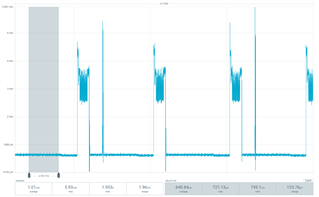Platform: nRF5340-DK
Tools: I am using SDK 1.5.0 (but seen on earlier SDKs too)
Configuration: Using high speed spi pins whether for SPI1 or SPI4
&spi1 {
compatible = "nordic,nrf-spim";
status = "okay";
mosi-pin = <9>;
miso-pin = <10>;
sck-pin = <8>;
};
If I use SPI1 I see around 40uA idle current draw when running my application
If I change to use SPI4 I see around 640uA idle current draw when running my application.
See attached screenshots taken from the power profiler app.
I would like to use SPI4 to enable the higher data rates, so I can get the SPI transfers over quicker and hence save power
However the jump from 40uA to 640uA idle current makes this unworkable
I was expecting maybe slightly higher current during operation, but not a huge jump in current when idle.
Is this a known issue?




